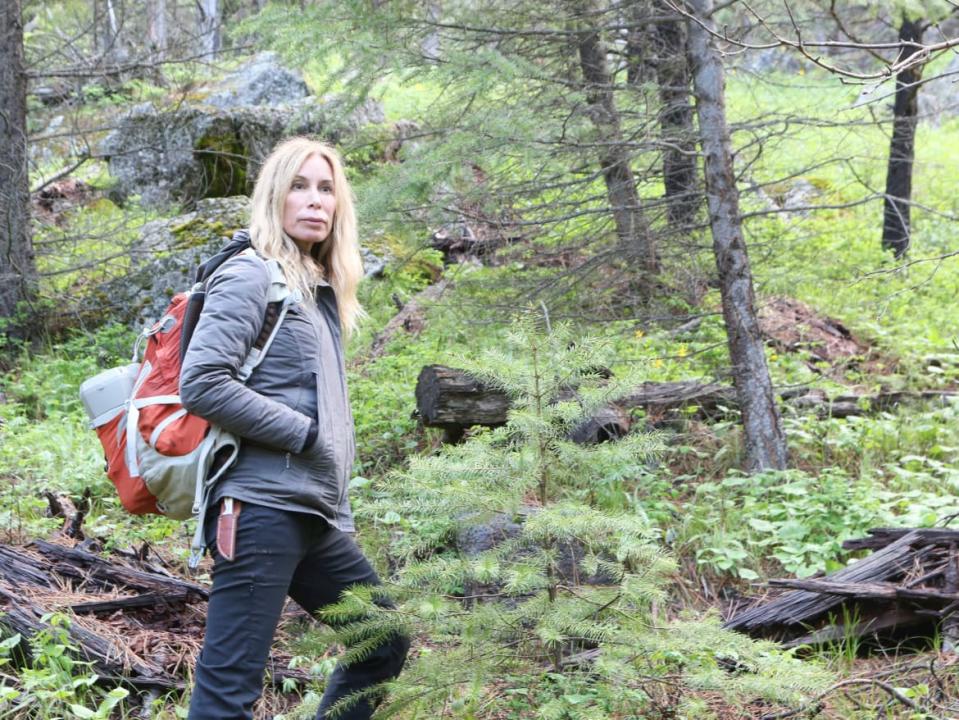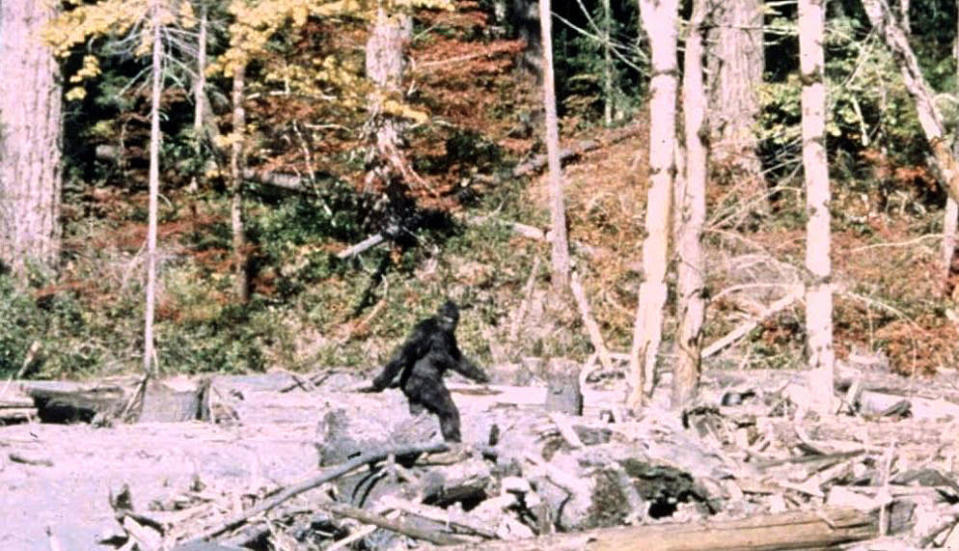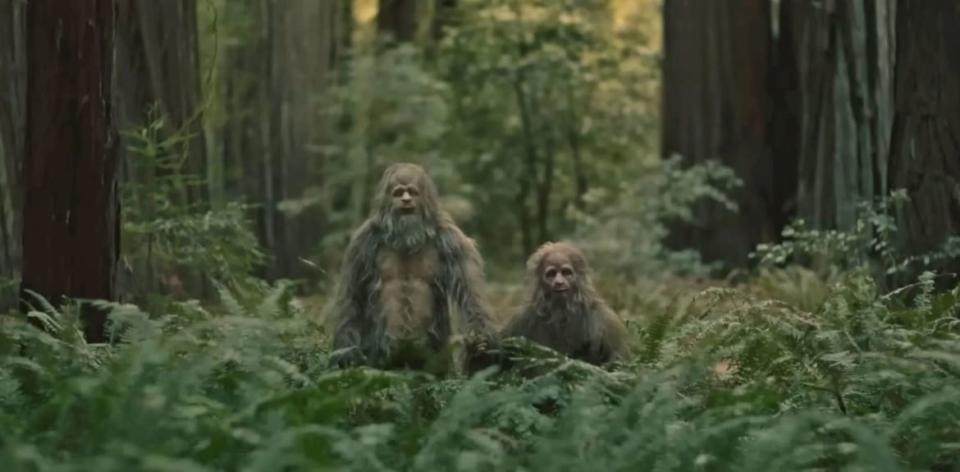There’s Never Been Anyone More Relatable Than Bigfoot

I’d understand if you labeled Sasquatch Sunset a farce. The new film from brothers David and Nathan Zellner, now playing in selected cities, follows an isolated Sasquatch family—a patriarch (Nathan Zellner), his beleaguered mate (Riley Keough), and their offspring, played by Jesse Eisenberg and Christophe Zajac-Denek. The family is objectively beastly; they communicate in grunts, snarls, and roars, and they’re covered in matted fur which barely camouflages their barbed genitals and grotesque teats. They release rip-roaring flatulence and streams of diarrhea into their idyllic surroundings, scratching their orifices with abandon. But their personalities are, against all odds, decidedly human.
Like humans, the Sasquatches engage in jubilant sex, then primly clean themselves with nearby foliage. Like humans, they get really, really excited when they find a turtle. And, like humans, they struggle with existential despair, sensing that their time—a time of ethereal flora and fauna, of abundant resources, of privacy and security—is coming to an end. So, no, Sasquatch Sunset isn’t a farce. It’s an expression of our collective anxiety pulsating in the wake of a relentless pandemic, ongoing economic uncertainty, imminent climate catastrophe, and unthinkable global atrocities. It’s also the latest in a recent spike in Sasquatchery throughout American pop culture. As Sasquatch mania sweeps the nation, one thing is clear: In the immortal words of mega-hottie Fox Mulder, we want to believe.

Expedition Bigfoot.
These days, if you go looking for Bigfoot, you’re liable to find him. The Travel Channel docuseries Expedition Bigfoot is currently on its fourth season, having premiered in 2019. In June 2020, World War Z author Max Brooks published Devolution: A Firsthand Account of the Rainier Sasquatch Massacre, a work of horror fiction set in the Pacific Northwest. On TikTok, there are 121,800 posts tagged under #cryptid and 167,000 tagged under #bigfoot, including dozens of responses to the alleged Sasquatch footage captured from a passenger train in southwest Colorado last fall.
In the sitcom space, a figure known as the Tall Man features heavily in the first season of FX’s Reservation Dogs; though the Tall Man’s traits, nomenclature, and symbolism vary among Native communities including Lakota, Seminole, and Sioux, the figure—along with Yokut Hairy Man and other spiritual and ecological guardians—was the blueprint for colonialist depictions of Bigfoot.
Cryptid lore predates colonialism, but the influx of cryptid content in American pop culture feels perfectly timely—a natural consequence of the post-pandemic era. In a 2022 CivicScience survey, 13 percent of adults in the U.S. said they agree with the statement: “Bigfoot/Sasquatch is a real, living creature.” Per the survey, that’s a significant increase from those surveyed in May 2020. (Worth noting: Ten new species were discovered in 2022 alone, including Bradypus crinitus, a newly recognized brand of sloth with a head that looks exactly like a coconut. Ah, foolish child, you might think. There’s no way a sneaky 12-foot hominid like Bigfoot has escaped mankind’s watchful eye. You’re right; Humans are famously observant. Just look at our annual traffic fatalities record.)

Frame 352 from the Patterson Gimlin Bigfoot film from 1967.
The rise in unorthodox beliefs makes sense when you consider the circumstances. Americans’ relationship to truth feels permanently mangled, thanks to public health authorities, politicians, and tech moguls who massage the truth on a recreational basis, sending it through an old-fashioned taffy pull until it’s barely recognizable. And Americans’ appetite for fantastical escape routes extends far beyond cryptid canon; the rise of the so-called “tradwife”—women who take to social media to recreate a domestic fantasy that never truly existed—alongside pseudo-homestead influencers (Ballerina Farm, anyone?) paint a picture of a world blissfully cleansed. Escapist influencers rake in the cash by promising that we can start over. We can go back. We can breathe deeply, undoing the damage done by our predecessors. We can choose another way.
‘Sasquatch Sunset’: The Pooping, Pissing Bigfoots That Are Disturbing Sundance
Of course, we can’t go back—which is why, as escapist influencers peddle a false past, cryptid mythology feels more and more socially relevant. Sasquatch Sunset shows the rapid decline of a family, likely the very last of its kind. Throughout the film, the Sasquatches demolish the natural resources available in their mountain home, greedily downing berries by the handful even as they suffer the digestive consequences. The family’s patriarch dies after trying to fuck a mountain lion under the influence of psychedelic mushrooms. Not long after, the eldest son, played by Jesse Eisenberg, follows in his father’s reckless footsteps, strolling over a submerged river log that eventually flips, crushing him as he drowns to death.
Only the one female (Riley Keough), her gentle youngest son (Christophe Zajac-Denek), and her newborn infant, a terrifying little cryptid crafted from the same mold as the Sewer Boys from Dicks: The Musical remain, and they are likely their species’ only hope. Even as they experience rare moments of euphoria—in one scene, they plunder a human campsite and experience the raw pleasure of housing Nerds and blaring ’80s pop—they are plagued with the knowledge that they are now completely alone.

Sasquatch Sunset.
I get the feeling. Personally, I used to believe in all sorts of things. Raised in the Evangelical church, I believed that God sent his sexy brunette son down to Earth in some sort of a gravity tube to save my soul. I believed in ghosts and monsters and demons scrabbling across the Earth, heads screwed on backward and tongues lashing hornily.
Now, as I stagger into my thirties, I don’t know what to believe. I’m years out of the church but still convinced that the infant Christ is somehow responsible for the safety of the nation’s commercial airlines. I spent my late twenties wading through 24 seasons of Law and Order: SVU, two bouts of Covid, one layoff, and a handful of emails from middle-aged Midwestern men who think my writing is too crass for a young lady. I’m left with a Fox Mulder-shaped hole in my torso, crusting over with disillusionment and threatening to form a heinous scab unless I can find something to believe in.
‘Challengers’ Is a Grand Slam of Sex and Sweat
That aimlessness—the terror and boredom of uncertainty—hits hard in the final scene of Sasquatch Sunset. Keough’s motherly Sasquatch arrives in a parking lot with her sons, having been driven out of their habitat by wildfire. They blink, stunned, as they’re faced with what initially looks like another Sasquatch. It is, of course, a statue—a slab of wood carved in their shape, standing menacingly outside of a cheap-looking Bigfoot museum. At that moment, the family realizes what we already know: It’s too late for them. They’ve already become a myth.
With that final scene, Sasquatch Sunset underlines Bigfoot’s status as a stand-in for humanity writ large. It may be too late for the farting, scratching Sasquatch, but we humans still have a chance to plunge forward into a more hopeful future. We just have to find something to believe in.
Get the Daily Beast's biggest scoops and scandals delivered right to your inbox. Sign up now.
Stay informed and gain unlimited access to the Daily Beast's unmatched reporting. Subscribe now.

 Yahoo Sports
Yahoo Sports 
